Bike Boulevard a Bad Idea
Not good for bikers, and will make other streets less bike-friendly, too.
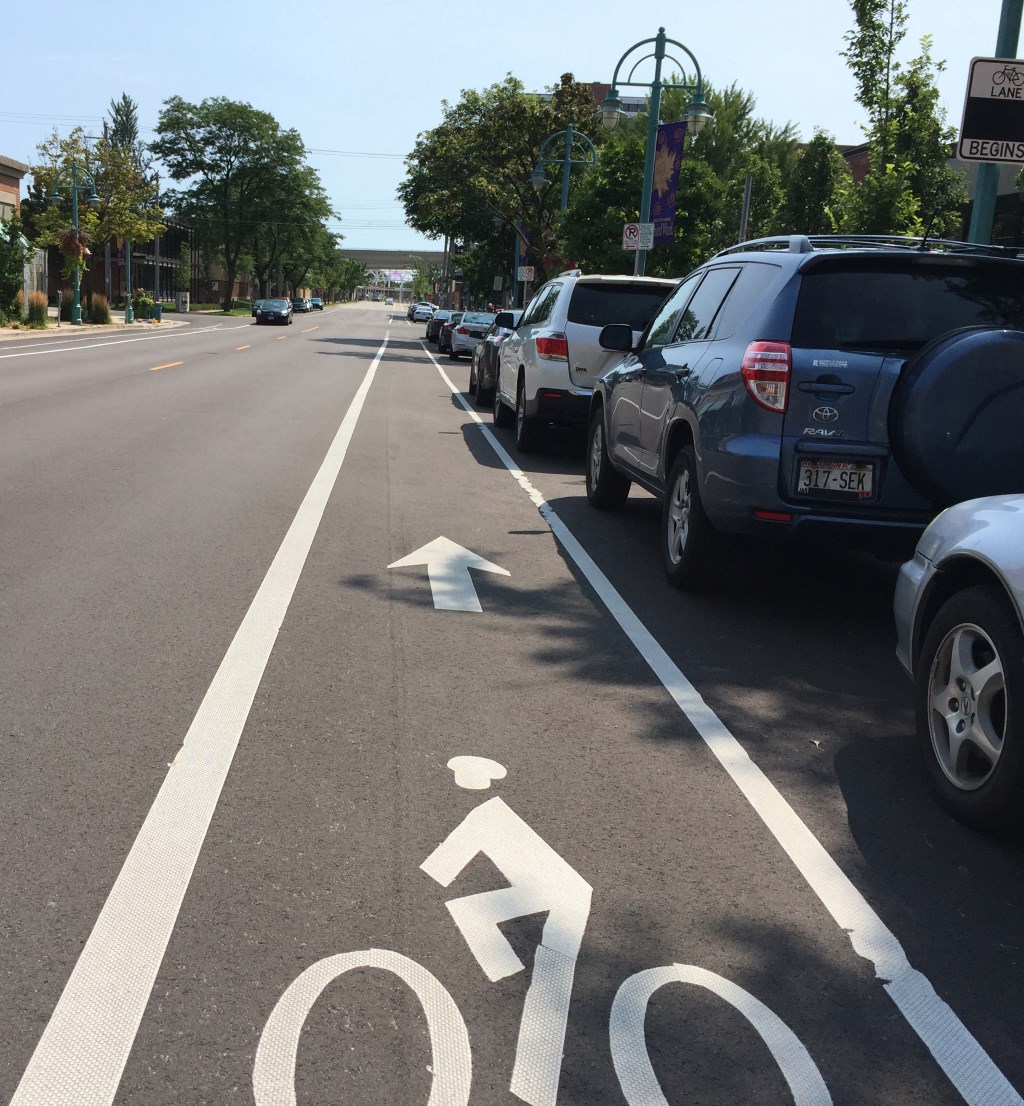 There’s a plan to make a bike boulevard in Riverwest along Fratney Street. Bump outs, mini traffic circles, and speed humps to slow cars down. A worthy goal, for sure.
There’s a plan to make a bike boulevard in Riverwest along Fratney Street. Bump outs, mini traffic circles, and speed humps to slow cars down. A worthy goal, for sure.
Hitting a speed hump in a car at 40 mph can bend a strut, blow the seal, or break a ball joint. That will teach you.
But have you ever hit one of these things on a bike? I have. Every cyclist has a story of the tragic consequences of hitting something like a pot hole, stone, or branch on the street. Anything sticking out of the pavement that slows a motorist can be much worse for someone on a bike with thinner tires, no shock absorbers, or a protective steel body. Instead of bending a strut cyclists can break an arm or a shoulder.
Making a street worse for everyone can’t be the answer to how to how to get motorists and cyclists to play well together.
Speed bumps or humps would be a blunder on a bike path. So why are they on a “bike boulevard”?
Because the “bike boulevard” is about automobile traffic — a response to neighborhood complaints about cars speeding down the street, according to Ald. Robert Bauman. “We have do something rather than nothing,” he told me.
Perversely this “bike boulevard” will divert traffic to the less traveled smaller streets that many cyclists prefer west of the river. North Pierce and Bremen streets are six feet narrower than Fratney, so they have fewer cars to begin with. Small enough so cyclists take a lane for themselves and ride down the middle of the street instead of being pushed over to the side where open cars doors are a hazard.
Does anyone know a commuter cyclist in Riverwest who thinks the bike boulevard is a good idea?
There are lots of ways to ride through Riverwest and not too many cars except perhaps on Fratney Street.
Everyone benefits when a street is an unobstructed thoroughfare with a uniform surface. The smoother the better. Commuter cyclists plan their routes and go out of their way to ride recently resurfaced streets because they are safer and infinitely more pleasurable to ride on — Humboldt, Michigan, Center, Farwell, Holton, and 2nd streets to name a few.
Don’t call this a “bike boulevard.” It’s actually about automobiles — like everything else in America, the only and last civilization on earth built entirely around the automobile.
The United States made 90 percent of the automobiles in the world in the 1920‘s and by 1928 consumed more than three million cars compared to Denmark’s 3,453. A roadside culture sprang up in America to support our love of the automobile. The first drive-in theater and drive-in restaurant were created in the 1920s, along with the motel and the roadside hamburger stand. The first drive-thru bank cropped up in St. Louis in 1930. The road-trip in art, literature, film, and music is a uniquely American phenomena.
Cars are not another form of transportation, but a form of culture. The American Dream was to never get out of your car.
If every trip on city streets were valued equally it would be perfectly natural for a person in a 3,000-pound vehicle to defer to someone on a 22-pound bike or a 100-pound child crossing the street. Walking three mph or biking 10 mph for 20 minutes rather than driving 65 mph to work is better for the environment and a lot safer. When we bump into someone on the sidewalk we say “excuse me.” On the freeway we call an ambulance, the police, and our insurance company.
Changing the national culture requires leadership and new policies that govern our city streets. Invert the pyramid, give the pedestrians the right of way, then bikes, and cars. But until that happens, we’re better off making smooth streets for two- and four-wheeled vehicles.
Speed bumps are not the solution, they state the problem: The automobile is sewed into the seams of America.
That’s not a design problem. That’s a national mind set, and won’t be altered in the least by a bike boulevard.
In Public
-
The Good Mural
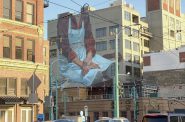 Apr 19th, 2020 by Tom Bamberger
Apr 19th, 2020 by Tom Bamberger
-
Scooters Are the Future
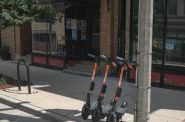 Dec 19th, 2019 by Tom Bamberger
Dec 19th, 2019 by Tom Bamberger
-
Homeless Tent City Is a Democracy
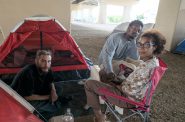 Aug 2nd, 2019 by Tom Bamberger
Aug 2nd, 2019 by Tom Bamberger
Transportation
-
MCTS Adds 28 New Buses
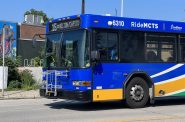 Jul 13th, 2024 by Graham Kilmer
Jul 13th, 2024 by Graham Kilmer
-
MCTS Designing New Bus Shelters
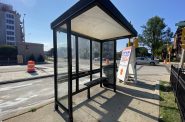 Jul 10th, 2024 by Graham Kilmer
Jul 10th, 2024 by Graham Kilmer
-
MCTS Updates RNC Bus Detours To Better Serve Downtown, Riders
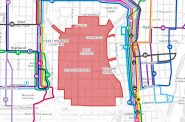 Jul 9th, 2024 by Jeramey Jannene
Jul 9th, 2024 by Jeramey Jannene




















You bike people are well organized, but it’s getting ridiculous. I don’t see swarms of bikers commuting to work. Why are our streets being remodeled one after another for this small group? My real beef is not the lanes, it’s aggressive bikers who act as if pedestrians like me, especially when walking my dog, are in their way when we hike the trails. If bike traffic is prioritized over cars, it follows that pedestrian traffic is also worthy of protection. Hey bikers: your personal Tour de France is only happening in your mind, it won’t hurt you to slow down or even stop for a moment to avoid hitting an animal.
I for one am glad to see projects like this move forward. Having ridden on Bike Boulevards in Portland they sure were nice. And I’m glad to see an idea started by some bicyclists bubble up to the city. That said, I look forward to some serious bike infrastructure… aka cycletracks (or the US version protected bike lanes).
There are many wrong assumptions and outdated ideas in this article. Speed “bumps” and speed “humps” are entirely different, and the undesirable speed bumps were never part of the plan for the bike boulevard (nor are bumps used in any national standard for bicycle boulevards).
He neglects to mention that in the space of 1 mile on Fratney there are 3 Elementary schools with playgrounds and large walk/bike-to-school populations, a very vulnerable group of road users.
He doesn’t seem to understand that in many situations a bike boulevard is created not to divert large amounts of car traffic but rather to slow down existing car traffic.
He also doesn’t seem to understand that the 2 major north-south bicycle routes through Riverwest (Holton and Humboldt) are dangerous for people on bikes and have faster car traffic (higher speed limits and higher overall vehicle speeds) than any of the internal streets in Riverwest.
He also doesn’t seem to know that the whole idea of Milwaukee adding bicycle boulevards and neighborhood greenways (which are two different ideas, by the way) came from 2 consecutive City of Milwaukee Bike/Ped coordinators and advocated for by multiple groups of local bicycle and pedestrian advocates.
This is just an unresearched rant that talks more about drive-in restaurants than actual relevant policy or infrastructure planning.
I think the designation “Bicycle Boulevard” is counter-productive. The obvious issue throughout much of Milwaukee is just that streets were widened out to comical widths reducing front lawns while driving up maintenance & snow removal costs, and providing virtually no transportation value. Corner lots were blown out across the city to widen turn radiuses so you could make a turn at 15 miles per hour instead of coming to a rolling stop (of course there’s moving traffic and no merging lane to so it’s obscenely dangerous).
We could shave 10 feet off almost every street, add those little neighborhood traffic circles in spots/4-way stops in most, close up those mini-turn ramps/restoring corner lots. It would raise property values, while being cheaper and safer. Much better for pedestrians & bikers at the same time.
This article is a joke, and only adds more confusion to the subject while providing very little in terms of solutions. Congratulations.
Why is it in bold typeface?
Danny, as a cyclist I do apologize on behave of my fellow bikers. I feel like cyclists, on a whole, are judged more harshly than other users because it’s easy to notice the A-holes out there. While the majority of us who prefer to follow the rules are never noticed.
That said, the boulevard is a good idea that might not be perfect in it’s conception, but it’s a step in the right direction.
Also, the roads are being redesigned to encourage more cycling use. And from what I can see, it’s been very effective. Ridership in the city is probably at an all time high.
The national car-centric mind set….”won’t be altered in the least by a bike boulevard.” Is that how Bamberger determines failure?
I’m not sure the city was setting their goal quite that high with their neighborhood speed bump plan. Most likely they want to brand a few speed bumps as “pro-bike”, rather than “anti-car”. So, cars and bikes slow down, what’s the harm in that?
On second thought, how much will they slow either bikes or cars? Take a ride on Cambridge Ave just across the river. Cars still drive pretty fast down Cambridge, up until they slow down to tackle the obstacles. Biking on Cambridge? I prefer to bike on Cambridge Ave rather than Bartlett or Newhall. I guess that’s the case for a number of reasons. Bart and New are terrible pothole-filled streets, and there are nice trees on Cambridge. My point is that the speed bumps are hardly a substantial drawback. I think Bamberger is greatly exaggerating the danger, and inconvenience of biking over speed bumps. Though, he won my click with his provocative take.
We don’t have ‘bike boulevards’ in Seattle, but there are multi-use trails like the kind I grew up riding in the Milwaukee area. They are quite safe, but they don’t serve many destinations directly. Recently Seattle Greenways worked with SDOT to develop a carefully shaped speed cushion. Many of the streets near my house have them. They encourage you to drive an even speed under the speed limit unlike the stop-speed-stop ‘bump’ profile. They are safe to bike over. The school zones are much better now. There is also a side street that became a designated ‘greenway’ route in cooperation with Seattle Childrens’ Hospital to a separated trail. Car traffic is now calm enough I can commute safely 10 miles to work even in dark wet Seattle winters. The fire department is now working with SDOT to improve the techniques even more.
http://sdotblog.seattle.gov/2016/06/28/traffic-calming-and-speed-cushions/
I agree with the commenter that mentioned all the street widening this city did for two generations. Cars have had their way, and now forced to share just a little, they get all self righteous. Center Street is an example of this asinine policy. its a wide road, ugly and dangerous. No one walks on Center Street and most avoid it. Outside of a handful great establishments, most of the storefronts suffer from disinvestment, neglect or paint over their windows. We need to do our corridors better. That means they need to be safe for biking and pedestrians.
Sam says I don’t “seem to understand that in many situations a bike boulevard is created not to divert large amounts of car traffic but rather to slow down existing car traffic.”
Read the book by Tom Vanderbuilt called TRAFFIC, you can find it here….
https://www.amazon.com/Traffic-Drive-What-Says-About/dp/0307277194
Starting around page 260 is a long discussion of speed humps and bumps. In fact these traffic calming devices divert traffic and cause other problems as well.
I rode a bike on a bike boulevard in Portland that’s served as a model elsewhere, including Milwaukee presumably. The speed humps threw me a bit at first (no, not literally), but they were much more gradual than typical parking lot humps and became pretty easy to accept. Overall, it was reassuring to be on a calm side street that prioritized bike traffic and made cross-traffic stop or yield before proceeding. That’s definitely an issue in Riverwest where every third intersection or so features a stop on Fratney but not the cross-street, forcing cyclists to stop and look for onrushing cars (or as human nature goes, to slow down and try to detect any cross traffic while easing into the intersection). I think it could work.
How many pedestrians and cyclists have been hit by drivers this year alone? How many of those incidents were high speed, dangerous hit & runs???
-Enough said on this subject, reckless driving and careless drivers need to be taken care of, and if that is done by traffic cameras, speed bumps/humps or any other tools or ideas, I am all for it.
This response article fails on multiple levels – though its honest critique is good to encourage dialogue. Is author sure that the purpose of Bike Boulevards is to improve bicycle commuting? What research, if any, was done before penning this article?
For all of the timidity in our cities culture – we often fail to look at successes elsewhere and plan (or in this case critique a plan) like we’re recreating the wheel. I used to live on a highly effective bike boulevard in Eugene, Oregon (12th Street). It was flanked on either side by arterial – ways (think of Prospect and Farwell). Many bike commuters used the bike lanes on the 1-ways (11th and 13th) because they are main traffic streets and the signals made biking was faster. This did not negate the need for 12th Street bike boulevard. The Bike Boulevard was highly used by bicyclists, however this was better suited for casual riding rather than ‘commuting’ (let’s remember that people go places besides work – so why should we consider biking for only ‘commuting’). Commuting (whether in a car or bike is often done solo). Going out for dinner, and other social activities are more likely to happen in groups. Bike lanes are good if you’re going somewhere solo – they’re not nearly as nice for groups.
To get away from the car culture described by Bamburger we should embrace and plan for biking for every destination rather than just getting to work. Moreover, I believe first and foremost the bike boulevard is actually about kids (not cars – as Bamburger suggests). By discouraging traffic on a bike boulevard, streets become safe for families to ‘commute’ or just get around. Where do families with kids ‘commute’ to? Schools. I believe that Fratney is in fact the perfect street for a bike boulevard – in fact moving here in 2007 I was surprised that a progressive neighborhood (Riverwest) in a progressive city lacked a boulevard on Fratney. At the time the reason Fratney made sense to me was the traffic signal on Locust, good condition of pavement, equidistance between Humboldt and Holton. The fact that the RW coop was located on Frateny also helped. However, after getting to know the neighborhood and hearing the proposal a few years back I was delighted for an altogether different reason. There are so many schools on Fratney (Pierce Street, La Escuela Fratney, Messmer). This would allow parents to much more safely and comfortably bike their kids to school or to have the kids bike on their own with friends. Good planning shouldn’t be about mobile adults and our safety, it should be about making our cities safe for the mobility of kids and seniors (for everyone 8 to 80).
Additionally – in Eugene – living on a bike boulevard, made my life better even when I wasn’t riding – I had very little traffic going down my street and many bicyclists going by. I would see friends and we could interact without as much fear of cars going by. This would be even more beneficial for families living on Fratney reducing fear of cars.
With all of that said – sure criticize speed humps or bumps – they’re not the best for bicyclists (though not nearly as bad as tracks) the way to do a bike boulevard correctly is to have 2 reverse 1 ways. In this case, I would have them meet at Center Street. This only requires the investment of two signs (and a whole lot of political will). It discourages cars from traveling along the entire street. Anyone driving to a destination just needs to go around an extra block (or thru the alley) if they live on the block immediately before after the 1-way switch.
Rather than just critique ad nauseum – let’s hear some solutions to addressing car culture’s cancerous dominance on our society. I, for one, think the boulevard on Fratney is a great place to start and despite my misgivings about its imperfections my biggest critique is that it wasn’t done several decades ago. After all, any innovation is bound to have flaws, after some thoughtful consideration and public input – there’s been plenty of both for this project – the most important thing is to do something, learn, and improve upon it.
@Tom Bamberger
Your concerns about speed bumps have already been dealt with by all the national standards for bike boulevards, you can read about it here: https://nacto.org/publication/urban-bikeway-design-guide/bicycle-boulevards/speed-management/
In addition, when Kristin Bennett, the former Bike/Ped Coordinator for the City, wrote the federal grant for the Fratney Bike Boulevard, she explicitly left out speed bumps AND speed humps because both in Wisconsin and her former job in Boulder, Colorado the city snowplowing operations struggled with both of those things.
Nasty speed bumps were never a part of the plan. They are still not a part of the plan. Your anger towards the entire project is misplaced.
And why is it such a bad thing if non-essential traffic is diverted off of Fratney Blvd? No one has claimed that there is too much traffic on Fratney, just that speeds are too high in certain areas. The city has a grid system for a reason. Holton and Humboldt are perfectly suitable routes for car traffic if they don’t want to deal with diverters on Fratney.
@tom bamberger: How much through traffic is going N/S on Fratney? About how many cars a day will get diverted… 2 or 3?
You’re applying concepts you don’t understand to things that you just don’t like because nostalgia.
SAM
If as you say, ” non-essential traffic is diverted off of Fratney Blvd”, then where does it go? Like I said and you disputed — to the streets next door.
STEVE
“The speed humps threw me a bit at first (no, not literally), but they were much more gradual than typical parking lot humps and became pretty easy to accept.”
Why accept them? Just the other day I rode over a speed hump. Yes, they are less bad than bumps and about the same as medium sized pothole. Why are we making our roads less bad instead good?
Putting humps or bumps in a road treats the symptoms and exacerbates the problem for others. Whatever value it brings for residents on their street (ie less cars) is then subtracted from the adjacent streets. As I said in the article, it’s the car culture in America that has to has to change.
@Tom, aren’t these steps help to help shift that car culture you keep referencing? Do you live in Riverwest, have you biked through the neighborhood on a regular basis? People already speed through all of our streets as those drivers do throughout the entire city. Installing anti-speeding measures while increasing the safety for pedestrians and cyclists alike should be an obvious agreement especially when reckless driving is such a large issue in our city.
You keep stating what you are against and why, along with talking about a needed shift in the culture of drivers. What solutions would work better in your opinion?
Isn’t it obvious from the article? Tom B lives on either Pierce or Bremen and is offended that even one car will divert off of Fratney and start speeding down his street. I’d agree with him. Improving only one street — no matter the intention — will divert traffic, and in a lot of cases, that’s the point. I hope that the city will use some data (e.g. start long term monitoring on all three streets now) to ensure that neighbors that aren’t immediate beneficiaries aren’t unduly harmed. And if that means Bremen and or Pierce get some traditional speed humps (which have been blessed from a design POV, if not from the POV of every plow driver), then so be it.
As for riding over a speed bump, nonsense. My kids can do it.
I like the “reverse one-ways” suggestion that was in one of the comments…
And, to whomever suggested narrower roads, I’ve got a jackhammer and some shovels…where do we start?
Rich and Taylor–
I used to live in Riverwest and rode though it frequently this summer.
Also, I am not suggesting one cannot navigate any sort of permutation of a street. Just seems obvious that a good road or bike trail would not would have bumps or humps.
All I am saying is the drivers are the problem not the design of the road. If speed humps are the answer for Fratney, then why put them on all of our streets. That would be absurd but you get my drift.
No solutions bamberger is at it again!
The design of the road influences how drivers actually drive. Read it again. It’s that simple.
Tim, this is best I can come up with regarding solutions… from the story.
“Invert the pyramid, give the pedestrians the right of way, then bikes, and cars.”
Plenty of us came up with real solutions. Bike boulevards, neighborhood greenways, Complete Streets policies. We’ve been advocating for these for a while now and making an appreciable difference in the lives of bike riders and walkers. At some point theory has to be put in practice and we can’t wait any longer.
@Sam Thanks for the hard work… Glad to see these urban ideas moving forward.
Why does Urban Milwaukee continue to post Tom’s poor articles? Some quality check would be nice or just stop posting his nonsense in general.
It isn’t just Tom either, and it’s why I won’t become a paying member.
I’d rather have Tom taking contrarian stands I can disagree with (and sometimes learn from) than being stuck with unquestioned groupthink on most topics.
A lazy contrarian just adds more noise; the net result is less signal.
That suggestion to put them on all (or at least many) streets works great. When I was growing up in Wauwatosa my parents lobbied to not have our street repaired. The potholes slowed traffic and made it safer for kids in the neighborhood. Poorly maintained streets aren’t a real answer, though (I once blew out a CV joint on a pothole). Seattle’s policy, which I like much better, is allowing speed cushions in school zones on non-arterial streets. That includes public, private, pre-, daycare and I think playgrounds. It is in effect city-wide. We got some earlier this year in front of the elementary school. The street’s not scheduled to become a greenway until decades from now, but the speed cushions were a great first step.
http://seattlegreenways.org/wp-content/uploads/16-01-05-Speed-Humps-in-School-Speed-Zones.pdf
How does Urban Milwaukee even allow such opinion pieces to be published? Shouldn’t there be quality control? Yes, let me write about how the grass is blue and the sky is green. Hey, it’s my opinion, worth something, right? No, actually, it’s not.
A big, huge thank you to everyone who refuted this guy who has clearly never traveled or experienced cycling anywhere else.
Sam,
I am not advocate. I don’t get things done like you do.
I am writer and deal a lot with theories.
Looks like you are putting your theory into practice.
I just don’t agree with your theory. And now we can both see
how it turns out. That’s ok isn’t it?
Casey,
Why don’t you show everyone where I’ve gone wrong instead of merely asserting
my articles are of poor quality. That doesn’t help anyone understand anything.
You can contribute to discussion.
Or is just that I disagree with you?
That can’t be a good reason something is dead wrong unless you are right all the time.
I would like to see a bike boulevard running from the East Side to downtown, that would serve as a safer and less hectic alternative to the Prospect/Farwell race track. It would be particularly attractive to families.
Bruce….
I don’t understand your comment. There is no problem getting from the East Side to Downtown. A glorious bike path with a gentle grade downhill runs a mere 100 yards to the east of Prospect from the East Side to downtown. Check it out.
@Tom “There is no problem getting from the East Side to Downtown. A glorious bike path with a gentle grade downhill runs a mere 100 yards to the east of Prospect from the East Side to downtown. Check it out.”
This seems very much like a car oriented mindset in regards to bicyclists. “There’s a trail over there why do they need a bike lane… etc.. etc..” The fact is bicyclists like pedestrians and even like those behind the wheel of an automobile need multiple routes.
Dave,
One sentence puts me in the car-oriented mindset? In my article I say invert the right-of-way on our streets — pedestrians first, then cyclists, then cars. I am really at a loss on the internet about how to get people to read the whole article, only 700 words, before they made up their mind about this or that.
Regarding the comment on Bruce Thompson’s post — he was talking about the problems with Prospect, for example. Well, there is a bike path just down the hill. That’s all.
@Tom Yes the Oak Leaf is there, but your suggestion to Bruce reads like this: there is already a bike trail why should we make other streets bike-friendly. Seems pretty car-oriented to me. Alternate version: there’s a sidewalk on Prospect why do we need it on Farwell?
First of all – I would like to thank Tom Bamberger for initiating what is clearly an important discussion. Though I still take issue with some of his points, I do better understand his intentions of inverting the priority of streets towards pedestrians and bikes. I also see that he has done research on the topic which I appreciate. I would simply state that he is wading into dubious waters to criticize something that people have been working on for years when there are a number of naysayers who fall on the other side of the spectrum – those who think streets are for cars only anyone else using them deserves to become a part of the pavement themselves… I would encourage him and anyone else who advocates for pedestrians and bicyclists who has some legitimate skepticism about bike boulevards to do some ‘field research’ by traveling to places where they have been effectively implemented before criticizing them outright (numerous West Coast Cities have effective Bike Boulevards). I can’t quite tell if this article was against the concept of bike boulevards altogether or the particular components of the proposed Fratney Boulevard. Without this practical experience – I would urge critics to hold their critique given the real, everyday danger posed to bicyclists in Milwaukee who lack the investments from these important investments (though a Bike Boulevard done well actually doesn’t cost much money at all – mostly signage – the investment is much more so in terms of political capital as referenced in my earlier comment).
In regards to Bruce’s comment about Farwell & Prospect I whole heartedly agree that there is a need for an improvement for bike infrastructure. Tom is your reference to an existing ‘bike path’ the Oak Leaf? Please keep in mind that a true bicycle city invests in multiple different options for bicyclists as Dave noted. Once again – it seems you are focused solely on a commuters needs. The Oak Leaf is great for a pleasure ride or getting to/from downtown (admittedly that was Bruce’s point) but to think of people biking around in the corridor between downtown and eastside with an intention to stop a few times along the way (running errands for example) restricts bicyclists to certain ‘exists’ from the bike path.
I have actually conceptualized an effective solution to the issue brought up by Bruce and would welcome feedback – yes both positive and negative – though anyone out there who thinks streets are for cars alone should move next to a freeway for a few years before commenting.
Proposal (drum roll please) extend the BRT to UWM (once BRT is built). 1 dedicated lane for BRT and 1 for cars. Take away parking on one side of Farwell and one side of prospect. Shift remaining parking off curb aprox. 6 ft and BAM – Between curb and parking lane you have a protected bike lane (Chicago has recently implemented protected bike lanes using set off curb – however it is not super effective because they have bikes traveling in both directions in a space that should really only be one direction – this would be much better with bike lane going just one direction)
Once again – the infrastructure for biking would cost essentially $0. Just the political capital to do this. And of course the BRT costs $ – but Federal money (assuming we have a Federal gov. in the future) supports BRT, cheaper and more effective than Streetcar for this corridor (not to mention BRT is more friendly than Streetcars towards bikes i.e. no tracks). And since I would hope bicyclists are advocates for multi-modal, I will tangentially add this is a prime corridor for BRT, lot’s of bus riders along the stretch from UWM all the way to Medical college.
– Your resident solutionary
Dave, I understand why you see it that way. It’s your re-framing of what I said. Is there no way to understand this sentence outside of car-oriented v pedestrian oriented debate?
I am still flummoxed. Is there any reason to believe reading this story or any other one I have done that I fall on the car side of the equation?
Has language lost all of its innocence? I tried to be as direct as possible.
“There is no problem getting from the East Side to Downtown. A glorious bike path with a gentle grade downhill runs a mere 100 yards to the east of Prospect from the East Side to downtown. Check it out.”
Damn DeMarsh, back at it again with reasoned arguments!
Addressing/Reinforcing other points above:
1. The Oak Leaf Trail is a great resource, but it is highly limited in its use for commuters.
2. Having a major (hopefully protected bike lane) route North-South through downtown is a huge need for commuting/transportation cyclists, and has been requested by a large amount of bike riders for years.
3. That route should be Holton->VanBuren, although Milwaukee St is a great option too (as long as they tear out the horribly stupid boulevard crap in the Third Ward). Connecting RW/Brewer’s Hill down through Third Ward is a good idea (and VB is wide enough the whole way).
4. BRT is a great idea but I’m worried that the city will screw up the implementation and that busses will still get caught in traffic, eliminating the “Rapid” part.
5. Protected Bike Lanes on Farwell and Prospect is a great idea that has (as you might expect) been suggested for years. The real problem is that any traffic solution (for bikes or cars or BRT or whatever) still remains dead on arrival if it affects Personal Car Parking in any way. Incredibly sad that the city cannot look towards the future and force the citizens to get with the program. Street parking is a hugely subsidized luxury, and if the city remains beholden to it, we’ll miss our chance at morphing into a truly great modern city.
@Tom Bamberger: Regarding your “I’m not an advocate…[I’m a writer who deals with theories].” 324 of your 686 words in this article specifically address speed bumps and other non-smooth road furniture. That’s not a theory! You spend half your piece complaining about actual elements rather than focusing on (what you claim is) your actual point about how cities should flip how their DOTs plan roads/etc. A discussion of Complete Streets policies or Vision Zero advocacy would have made more sense, and this is already a vibrant discussion of those topics occurring across the nation.
Also, Tom, you question of “Does anyone know a commuter cyclist in Riverwest who thinks the bike boulevard is a good idea?” is highly insulting, seeing as the FUCKING ALDERPERSON pushed this idea into reality after ACTUAL BICYCLE COMMUTERS (who, by the way, did a lot of theoretical and practical research) PROPOSED THIS IDEA. It’s shitty writing at best, and privileged elitism at worst.
TOM: I spent 10 years working in Milwaukee bike shops and served literally thousands of bike commuters, while being a bike commuter myself. I have years of evidence that the Oak Leaf Trail is an entirely **insufficient** route for many if not most commuters heading downtown or through downtown.
Let me be clear: There ABSOLUTELY IS an problem getting from the East Side to Downtown for many bike commuters, and the issue is worse for those who are in Riverwest, Brewer’s Hill, or many other parts of the city.
I am not suggesting that you are being supportive of cars or car culture, but the arguments you are making are very much anti-bike infrastructure, which in turn is anti-bike/pedestrian. Just look at the comments on Facebook for this article, over half the comments use your article to deride bike commuters and justify the idea that any and all bike-specific road infrastructure is a waste of money and an attack on car users.
There are a dozen people in the comments here who are explicitly saying that your theories are incorrect, yet you are fighting with them claiming you’re just misunderstood. Maybe listen to these people before writing another article.
I should have clarified that the “FUCKING ALDERPERSON” in my previous comment is the amazing Nik Kovac, a bike commuter and entirely reasonable person.
Hoo boy, this is a contentious piece. I don’t have a lot of insight on bike boulevards, but my understanding is that they’ve been successful in other places.
I would, however, like to refute Mr. Bamberger’s claim that there is “no problem” getting from the East Side to downtown via bike. Even someone like me, who doesn’t bike *or* drive, can see how limiting an out-of-the-way trail is. The East Side is a large neighborhood, and downtown, too, has a bunch of different zones. Unless you are starting near a trail entrance and want to be dumped out on the eastern edge of the downtown, it’s not really that convenient. There should be other good routes on regular streets. I think that also helps businesses along the way, since people sometimes want or need to run errands along the path of a commute.
I’ve been reading Urban Milwaukee pieces for a long time, and my feeling is that Mr. Bamberger’s pieces often intentionally set themselves up as oppositional or flippant while lacking the nuance and subtlety of a good critique.
Ok guys, let’s stop wasting our time and effort arguing with someone who is against something he doesn’t even know. If anyone thinks the Oakleaf Recreation Trail is a bike boulevard, they’re more out to lunch than a Sunday afternoon picnic. And just so you know, tons of cities around the world know how to build speed bumps or humps for cars AND bikes, but again, that would involve traveling and getting to know the planet a bit more. Check it out in Sacramento:
https://www.cityofsacramento.org/-/media/Corporate/Images/Public-Works/Transportation/SpeedLumps.jpg?la=en
Like Vincent said, the fact that Urban Milwaukee continues to publish stuff from this author is one of the main reasons I just cannot be a paying member.